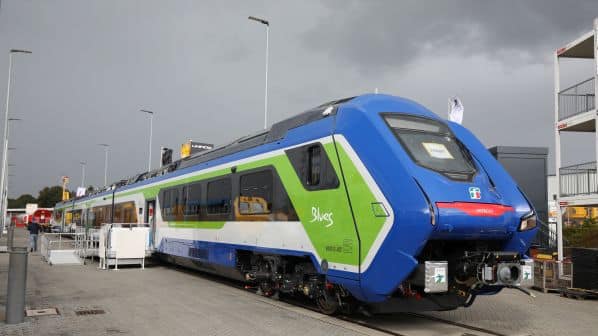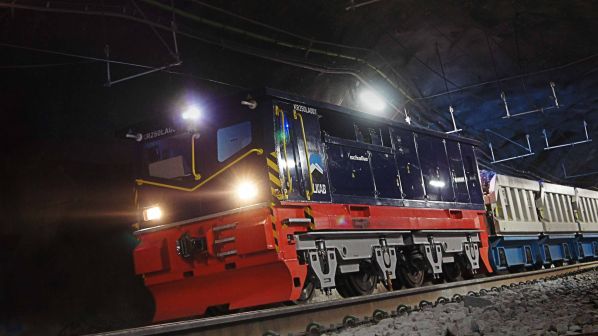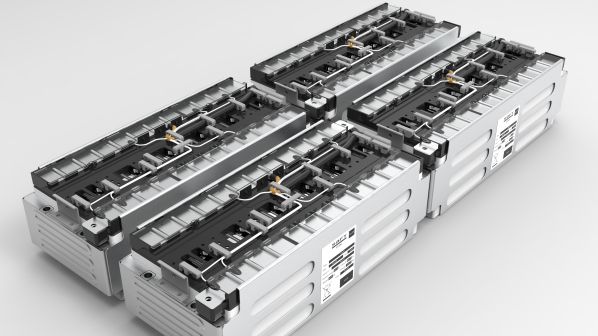THE history of battery traction in the rail sector may go back further than you might expect. Experiments with accumulator railcars were conducted from around 1890 in Belgium, France, Germany and Italy, while Edison-Beach type railcars with nickel-iron batteries were used in the United States from 1911. In New Zealand, a battery-electric Edison railcar with a range of 160km operated on the 34km Little River Branch line between 1926 and 1934, before it was destroyed in a depot fire, while a Drumm nickel-zinc battery was used in Ireland on four two-car sets between 1932 and 1946 on the Dublin’s Harcourt Street Line.
But while these technologies have existed for decades, battery traction has only recently been developed to a level where it is a viable alternative to diesel and electric traction on the main line. Although electrification remains the preferred decarbonisation solution, it is only suitable for lines with high levels of traffic: the break-even point on the investment required is estimated to be around four trains per hour in France.
While battery is often mentioned alongside hydrogen as the main alternative source of traction power, it is important to remember that a hydrogen fuel cell train is also a battery train. While a fuel cell provides the average level of energy required for traction, it cannot provide the instantaneous peak energy required when a train is accelerating. The fuel cell is instead used to continuously charge an intermediate battery, which the traction energy is then drawn from. The battery can also store energy from regenerative braking, further increasing efficiency.
The benefits of installing traction batteries are largely environmental, but there are additional benefits. Batteries can be optimised to power auxiliary systems such as heating, ventilation and air-conditioning (HVAC), often the second largest consumer of energy onboard a train. The battery can also be used to provide power during train cleaning or for movements within a depot, removing the need to raise the pantograph or start a diesel engine.
Estimates of the number of diesel trains currently operating within Europe that will need to be replaced over the coming 10 to 15 years vary from 2000 to 10,000, but what is not disputed is that these pure diesel trains will be replaced with diesel hybrids or pure electric or alternative traction equivalents.
“I’m not sure if we have a dedicated market for battery trains yet,” says Stadler’s director of marketing and sales, Mr Ansgar Brockmeyer. “We do have a market for trains without diesel traction, but it’s pretty open in terms of technology. So I think the market requires alternative traction. With one exception in Slovenia, there are no tenders out for pure diesel trains, and customers are just not buying diesel anymore.”

Tram and light rail systems were the first to employ battery traction, as their comparatively lightweight rolling stock means they require less power than a main line freight or passenger train. The first examples employed a battery that was charged at each stop, removing the need for catenary, while more advanced technology now allows the vehicle to run the length of a line on a single charge. This was particularly important in historic city centres, where operators and transport authorities were faced with the challenge of electric operation without the visual intrusion of overhead wires.
Now, advances in technology are resulting in battery traction being installed on shunting locomotives and regional passenger trains, while the technology is also beginning to enter the freight locomotive market. However, in this sector the move towards battery traction is slower, largely due to the higher tractive effort required and the slim margins that are a feature of the rail freight sector.
“[The cost] has come down but particularly because of the lifetime issue, it is still a significant aspect,” Brockmeyer says. “You have to exchange the battery two or three times in the lifetime of the train, which you wouldn’t necessarily have to do with a diesel engine.”
Research
While Europe is considered the leader of research into new battery traction, using mainly Asian-developed battery cells, work is underway elsewhere around the world. Much of the focus on the rail sector is on lithium-ion, an umbrella term for a range of battery types that use lithium, including lithium titanate oxide (LTO), lithium iron phosphate (LFP), lithium manganese nickel oxide (LMNO), and NMC, which uses a cathode made of a combination of nickel, manganese, and cobalt.
Battery manufacturers such as Toshiba are leading in this research, including through experiments with new materials. These are then purchased by battery suppliers such as ABB and Siemens, which package the individual cells into a base module and provide additional systems such as the cooling and battery management technology, before selling these packages to rolling stock manufacturers. Others such as Saft are manufacturing and packaging the cells themselves.
According to a report commissioned by Forsee Power and undertaken by E-Cube, LTO technology has been favoured for regional trains in Germany because it offers a relatively high power to energy ratio. But in France, where regional trains travel longer distances and with fewer stops, NMC or LFP batteries with higher energy density could be more suitable.
LTO is also considered to be one of the safest battery technologies. Some lithium-ion batteries can be volatile if damaged - the battery used in a mobile phone is likely to combust when punctured, for example.
“Titanate is the material of the negative electrode of the battery,” says Saft general manager rail segment, Mr Milan Sima. “The material in an LTO cell is less flammable than that in a cell containing a graphite electrode. This makes it much safer and the reaction if it is damaged very mild.”
“We have very, very high standards on fire protection, the trains have to be crash-proof and vandalism-proof… and of course, if we bring batteries or hydrogen on to the train, we can’t reduce safety,” Brockmeyer says. “That’s why some battery technologies just cannot be applied to the railways.”
However, LTO comes with a trade-off in that it has a lower power to weight ratio than some other types. The potential fire risks of other battery types can also be managed and mitigated through the use of battery management systems to prevent overheating and over or undercharging, which can all damage the cells.
Hitachi executive officer and group COO, Mr Koji Agatsuma, says Hitachi is exploring the use of NMC for high-capacity use and LTO for high-power applications.
“The state of battery technology is evolving and improving every day, but at this moment based on the latest technology there is no single integrated solution to cover both high power and high density,” Agatsuma says. However, he expects this situation to change with the introduction of solid-state lithium-ion batteries, which could enter the market within two years, potentially doubling capacity, charging speed, and power.
Hitachi Rail’s new Blues multiple-unit (see panel below) could be the first ever tri-mode train to enter passenger service in Europe when it begins operating with Trenitalia of Italy later this year, depending on when the Stadler Flirt tri-mode trains ordered by Transport for Wales enter service. Agatsuma says LTO batteries were selected for Blues to meet the requirements outlined by Trenitalia. Under battery power, the train can accelerate at 1.2m/s² up to 160km/h, and has a range of 60km.
New engineering
Most of the advances in battery cells are happening more gradually and are mainly focused on developing cells with a higher power to weight ratio. Other materials such as sodium are also being explored to replace lithium, the price of which has risen by more than 500% over the past 18 months due to supply chain bottlenecks and robust demand for electric road vehicles.
Combined with the relatively short lifecycle of a battery compared with the train they power, this can increase the overall lifecycle cost of a battery train compared with diesel or electric rolling stock. Most LTO batteries can operate for 20,000 recharging cycles, which typically means replacing them after eight to 10 years, with some lasting for 12 years. This is significantly shorter than the minimum 30 years of working life that is expected from new rolling stock. However, this does provide an opportunity for the battery technology to be upgraded when it is changed, as this is likely to have developed since the train entered service.
The faster charging times that are often needed in rail increase the current load on the battery, increasing the number of electrons that need to pass through the chemical process at a time, which ages the battery faster than trickle charging. Another major factor that affects battery life is the temperature at which it is kept, with research now examining the effects of cooling batteries to 30˚C or 20˚C.
The high number of charging cycles and the high loads exerted on batteries in a train mean that while the base technology may be similar, it is not as simple as taking a battery from an electric car and combining them to gain the higher power needed for traction. However, the rail sector is constantly monitoring other sectors, including automotive, marine and industrial, to ensure it is using the best technology.
“The batteries in cars are designed for cars in terms of lifetime and safety requirements,” Sima says. “Here we are looking at completely different environments.”

passenger service in Europe. Photo: Keith Fender
Train manufacturers are leaving the research into the chemical engineering to the battery manufacturers and are instead focusing on the battery management systems that charge and discharge batteries in a way that optimises operation while extending their lifespan. While a battery manufacturer may provide a two-year warranty for the cells themselves, the battery supplier or train manufacturer is generally expected to provide a battery pack that can last for at least eight years.
ABB has developed a remote condition-monitoring system for its batteries that provides a major insight into battery performance, how it performs and operates within a specific range. It is also able to identify weak cells within the battery and offers an online portal where users can check the health of their batteries.
A lithium-ion battery has reached the end of its onboard life when it loses between 20% and 30% of its overall capacity. Research is now underway into how these partially depleted batteries can be reused before they are recycled. One potential use is to install the batteries in static locations, such as quick-charge stations on light rail systems or to store energy from solar panels to power stations and other facilities.
Containing a range of rare metals such as copper, manganese, lithium, nickel and cobalt, more than 75% of the materials in a battery can be recovered and reused, Sima says. This will not be the sole responsibility of the rail industry, however, as other sectors such as automotive are expected to recycle much greater volumes of batteries and will need to build the facilities to process these, which in turn fleet owners could use.
Right solution
While rail is the most environmentally friendly mode of transport for moving both passengers and freight, Brockmeyer says this can only be achieved by attracting more customers from other modes. Because of this, he cautions against the rail sector using more expensive technology such as batteries just for the sake of it.
“Despite the fact that I’m an engineer and I like new technology and innovation, and from a technological point of view I find it really, really very appealing, we have to ask ourselves in the end, does this help our sector?” he says.
Many of the people IRJ spoke to share this sentiment. While they are excited by the possibility of introducing battery trains, there is sometimes too great a focus on individual technical solutions without first undertaking a full appraisal of whether it is the best or least expensive technology to decarbonise rail operation.
“We see networks that are suddenly converted into hydrogen networks, where a battery application is potentially more suitable,” Brockmeyer says. “There are other networks where people are saying ‘we have to go with battery’ where we think that perhaps battery is not the best solution. The operators should leave it to the suppliers to decide which technology is most suitable for the application.”
Legacy technology
Not all train manufacturers are looking to integrate the cutting edge of battery technology, with some instead focusing on technology that has already been tried and tested. Schalke, which provides battery trains for metros and mining applications, is offering products with lithium-ion batteries but says there has been no uptake yet.

“In our applications, we don’t need the fast charging which comes with the lithium batteries,” says Schalke managing director, Dr Gregor Brudek. “Our customers are still deciding to go for lead acid because it’s proven technology. Miners are very conservative and not keen to take risks. [Lithium batteries] are much more expensive, and there may be risks with fire protection.”
Deliveries of battery trains pick up pace
The rise of battery trains is visible in the number of orders that have begun to emerge across Europe and around the world in recent months.
Hitachi Rail unveiled its new Blues tri-mode multiple-units built for Trenitalia at InnoTrans. The manufacturer says this will be the first ever tri-mode fleet to enter passenger service in Europe when it begins operating later this year.
Siemens Mobility presented the Mireo Plus B battery train at InnoTrans. The two-car electric trains with 120 seats feature a battery hybrid drive and can operate for more than 80km under real world conditions in battery mode. It has secured contracts to supply the trains to Central Jutland Railways in Denmark and Lower Barnimer Railway in Germany.
German regional public transport authorities Rhine-Ruhr Transport Association (VRR) and Westfalia-Lippe Local Transport (NWL) signed a contract to order 63 BEMUs from CAF in April. The trains have a battery range of between 60km and 220km.
Last year, Irish Rail (IÉ) agreed a 10-year framework agreement with Alstom for up to 750 new electric (EMU) and battery-electric (BEMU) X’trapolis cars. The BEMUs have an 80km battery range, and are recharged via fast charging stations at selected terminus locations and via regenerative braking. Alstom has also sold its BEMUs to the Central Saxony Transport Association in Germany.
Progress Rail and Wabtec have set the standard for battery freight locomotives. Progress Rail is supplying its EMD Joule to the US and Brazil. Wabtec completed a three-month trial of the Flxdrive in California in 2021 before starting work on a more powerful version. The 192-tonne locomotive was fitted with 18,000 lithium-ion battery cells offering 2.4MWh of storage.
Stadler is supplying a class 93 locomotive for Rail Operations UK (ROUK), which features a tri-mode traction system supplemented by 400kW of extra power provided by two LTO battery powerpacks supplied by ABB. Also in Britain, Stadler is supplying seven Independently Powered EMUs (IPEMUs) for commuter operator Merseyrail, equipped with batteries to operate for 50km on non-electrified routes at up to 100km/h. Likewise, the tri-mode electric-diesel-battery Flirt multiple unit for Transport for Wales is equipped with batteries housed in a short central car for use on non-electrified sections of the network.
In addition, Stadler and the German Aerospace Centre (DLR) are collaborating to develop a modular, scalable battery system for multiple-units that can be optimally adapted for typical route lengths. The partners say this will enable them to determine the best weight and size of battery needed to power a train over a given route, helping to make operations more sustainable.
CRRC Zhuzhou is supplying two hybrid battery-powered shunting locomotives to Rail Cargo Hungary (RCH). The locomotives are equipped with LTO batteries charged from the overhead power supply on electrified routes. Power output is 350kW in battery mode and 850kW when drawing power from catenary.
Outside Europe, Energy Absolute took delivery of what it describes as Thailand’s first electric locomotive, a battery-powered unit supplied by CRRC Dalian in August. Energy Absolute says the locomotive has a range of 200km and would offer a 40% saving in energy costs when compared with diesel traction.

